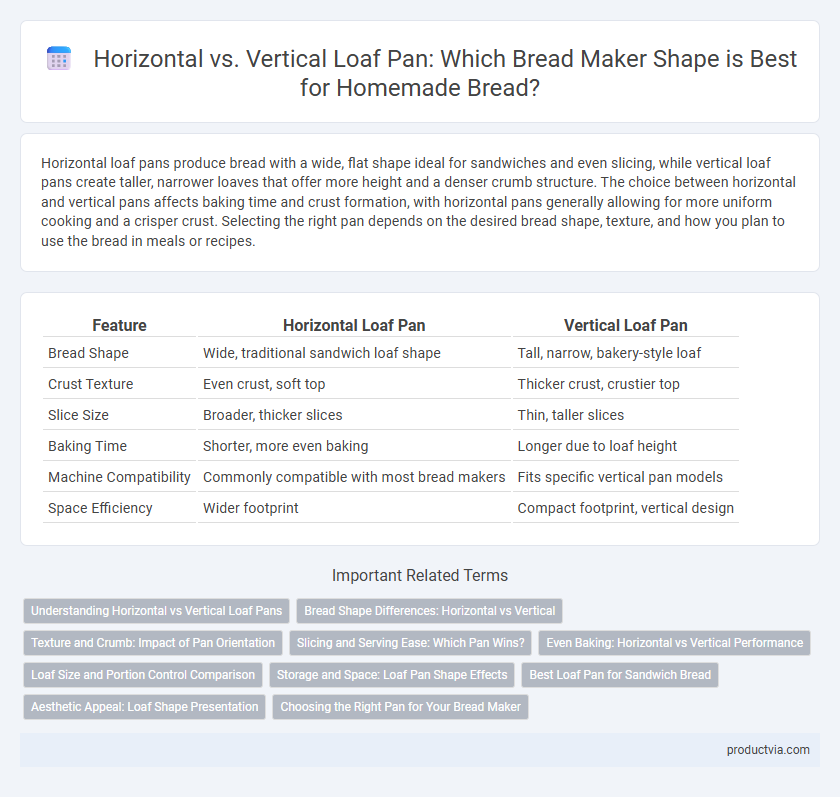Horizontal loaf pans produce bread with a wide, flat shape ideal for sandwiches and even slicing, while vertical loaf pans create taller, narrower loaves that offer more height and a denser crumb structure. The choice between horizontal and vertical pans affects baking time and crust formation, with horizontal pans generally allowing for more uniform cooking and a crisper crust. Selecting the right pan depends on the desired bread shape, texture, and how you plan to use the bread in meals or recipes.
Table of Comparison
| Feature | Horizontal Loaf Pan | Vertical Loaf Pan |
|---|---|---|
| Bread Shape | Wide, traditional sandwich loaf shape | Tall, narrow, bakery-style loaf |
| Crust Texture | Even crust, soft top | Thicker crust, crustier top |
| Slice Size | Broader, thicker slices | Thin, taller slices |
| Baking Time | Shorter, more even baking | Longer due to loaf height |
| Machine Compatibility | Commonly compatible with most bread makers | Fits specific vertical pan models |
| Space Efficiency | Wider footprint | Compact footprint, vertical design |
Understanding Horizontal vs Vertical Loaf Pans
Horizontal loaf pans produce wider, more traditional sandwich-shaped bread with a uniform crumb and crust, ideal for slicing and toasting. Vertical loaf pans create taller, narrower loaves with a more compact crumb structure, suitable for recipes requiring extra rising space or artisan-style bread. Understanding the pan orientation helps select the right shape and texture based on baking preferences and bread types.
Bread Shape Differences: Horizontal vs Vertical
Horizontal loaf pans produce bread with a traditional rectangular shape, offering a larger surface area ideal for evenly browned, crusty slices perfect for sandwiches. Vertical loaf pans create taller, more compact loaves resulting in thicker slices, which are preferred for hearty, chunky sandwiches or toast. The choice between horizontal and vertical pans affects crumb texture and crust distribution, with horizontal pans promoting a more uniform crumb and vertical pans yielding a denser interior.
Texture and Crumb: Impact of Pan Orientation
Horizontal loaf pans produce bread with a more even, consistent crumb and a softer texture due to the wider surface area allowing better heat distribution. Vertical loaf pans create a taller loaf with a denser crumb and chewier texture because the dough rises upwards, concentrating the structure. Pan orientation influences the crust-to-crumb ratio, directly affecting moisture retention and final bread mouthfeel.
Slicing and Serving Ease: Which Pan Wins?
Horizontal loaf pans produce wider, more traditional sandwich loaves that are easier to slice uniformly and serve due to their stable, flat structure. Vertical loaf pans create taller, narrower bread shapes that can be more challenging to slice evenly but yield thicker slices ideal for hearty servings. For ease of slicing and serving, the horizontal loaf pan generally offers better control and consistency.
Even Baking: Horizontal vs Vertical Performance
Horizontal loaf pans promote even heat distribution around the dough, producing consistent crust color and texture, while vertical pans sometimes cause uneven baking with denser bottoms and lighter tops due to heat rising dynamics. The wider surface area in horizontal pans allows moisture to escape uniformly, preventing soggy centers or overly thick crusts often seen in vertical pans. Professional bakers prefer horizontal pans for reliable, uniform loaf shape and texture essential in artisan bread quality.
Loaf Size and Portion Control Comparison
Horizontal loaf pans produce wider, shorter loaves that offer more uniform slices, making portion control easier for sandwiches and even servings. Vertical loaf pans create taller, narrower loaves, maximizing bread volume in limited counter space but often resulting in uneven slice sizes. Choosing between horizontal and vertical loaf pans depends on desired loaf shape and portion consistency for specific bread recipes.
Storage and Space: Loaf Pan Shape Effects
Horizontal loaf pans produce wider, shorter bread loaves that store more easily in standard bread boxes and sandwich bags, optimizing kitchen space efficiently. Vertical loaf pans yield taller, narrower loaves that may require more vertical storage height but save counter space during baking. Choosing between horizontal and vertical pans depends on available storage dimensions and preferred loaf shape for slicing and stacking.
Best Loaf Pan for Sandwich Bread
Horizontal loaf pans produce wider, traditional sandwich bread slices ideal for uniform toasting and sandwich-making, while vertical loaf pans yield taller, narrower loaves with a denser crumb and crust. For the best loaf pan for sandwich bread, choose a horizontal pan with straight sides and an even heat distribution to achieve a consistent crust and soft interior. Bread makers with horizontal pans optimize shape and texture, enhancing the sandwich bread experience.
Aesthetic Appeal: Loaf Shape Presentation
Horizontal loaf pans create a wide, traditional sandwich loaf with a uniform crumb and golden crust that enhances the visual appeal for classic bread presentation. Vertical loaf pans produce taller, more cylindrical loaves with a distinctive, artisan-style silhouette favored for decorative cutting and rustic aesthetics. The choice between horizontal and vertical pans significantly influences the bread's shape and overall aesthetic, impacting presentation for serving and gifting.
Choosing the Right Pan for Your Bread Maker
Choosing the right pan for your bread maker impacts the shape and texture of your loaf, with horizontal loaf pans producing wider, squat loaves ideal for sandwiches, while vertical loaf pans create taller, narrower loaves suitable for artisan-style bread. Horizontal pans often result in more even baking and crust development due to their larger surface area, whereas vertical pans may yield loaves with a denser crumb and a taller rise. Consider the type of bread you prefer--classic sandwich or artisan style--and the specific bread maker model's compatibility when selecting between horizontal and vertical loaf pans.
Horizontal loaf pan vs vertical loaf pan for bread shape Infographic

 productvia.com
productvia.com